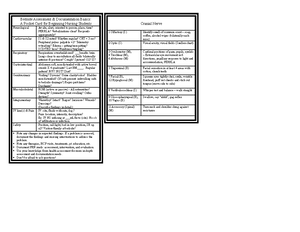- Information
- AI Chat
This is a Premium Document. Some documents on Studocu are Premium. Upgrade to Premium to unlock it.
Was this document helpful?
This is a Premium Document. Some documents on Studocu are Premium. Upgrade to Premium to unlock it.
MEDSurg hesi - HESI hints for exam
Course: Medical Surgical nursing (NURS 1341)
160 Documents
Students shared 160 documents in this course
University: Houston Community College
Was this document helpful?
This is a preview
Do you want full access? Go Premium and unlock all 11 pages
Access to all documents
Get Unlimited Downloads
Improve your grades
Already Premium?

MED-SURG HESI practice questions from the Saunders book
The nurse is preparing to assist a client with a cuffed tracheostomy tube to eat.
What intervention is the priority before the client is permitted to drink or eat?
Inflate the cuff
Rationale: If a client with a tracheostomy is allowed to eat and the tracheostomy has a cuff, the
nurse should inflate the cuff to prevent aspiration of food or fluids. The cuff would not be
deflated because of the risk of aspiration.
The nurse has implemented a bowel maintenance program for an unconscious
client. The nurse would evaluate the plan as best meeting the needs of the client
if which method was successful in stimulating a bowel movement? Glycerin
suppository
Rationale: The least amount of invasiveness needed to produce a bowel movement is
best. Use of glycerin suppositories is the least invasive method and usually stimulates
bowel evacuation within a half-hour.
A client is readmitted to the hospital with dehydration after surgery for creation of
an ileostomy. The nurse assesses that the client has lost 3 lb of weight, has poor
skin turgor, and has concentrated urine. The nurse interprets the client's clinical
picture as correlating most closely with recent intake of which medication, which
is contraindicated for the ileostomy client? Biscodyl
Rationale: The client with an ileostomy is prone to dehydration because of the location
of the ostomy in the gastrointestinal tract and should not take laxatives.
The client is complaining of skin irritation from the edges of a cast applied the
previous day. Which action should the nurse take? The nurse petals the edges of
the cast with tape Rationale: minimize skin irritation.
The nurse is taking a health history for a client with hyperparathyroidism. Which
question would elicit information about this client's condition? "Are you
experiencing pain in your joints?"
Rationale: Hyperparathyroidism is associated with over secretion of parathyroid hormone (PTH), which
causes excessive osteoblast growth and activity within the bones. When bone reabsorption is increased,
calcium is released from the bones into the blood, causing hypercalcemia. The bones suffer
demineralization as a result of calcium loss, leading to bone and joint pain
Why is this page out of focus?
This is a Premium document. Become Premium to read the whole document.
Why is this page out of focus?
This is a Premium document. Become Premium to read the whole document.
Why is this page out of focus?
This is a Premium document. Become Premium to read the whole document.




